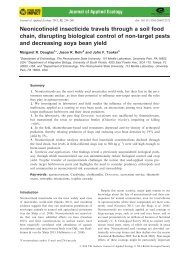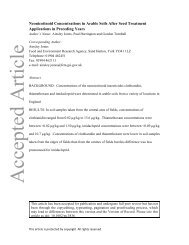g62-encyclopaedia-of-pests-and-natural-enemies-in-field-crops
g62-encyclopaedia-of-pests-and-natural-enemies-in-field-crops
g62-encyclopaedia-of-pests-and-natural-enemies-in-field-crops
- No tags were found...
Create successful ePaper yourself
Turn your PDF publications into a flip-book with our unique Google optimized e-Paper software.
Rape w<strong>in</strong>ter stem weevil (Ceutorhynchus pictarsis)Rape w<strong>in</strong>ter stem weevil (Ceutorhynchus pictarsis)Crops affectedCereals✔ OilseedsVegetable brassicasPotatoesCarrotsAlliumsPeasField beansSugar beetLettuceImportanceRape w<strong>in</strong>ter stem weevil is an occasional pest <strong>of</strong>oilseed rape. It first came to attention <strong>in</strong> 1982, when anumber <strong>of</strong> severe <strong>in</strong>festations were experienced <strong>in</strong>the east <strong>and</strong> south east. The ma<strong>in</strong> damage is causedby the larvae feed<strong>in</strong>g with<strong>in</strong> stems; adult feed<strong>in</strong>g <strong>in</strong>the autumn is not considered important.Risk factorsInitially limited to L<strong>in</strong>colnshire <strong>and</strong> Cambridgeshire,the pest has now spread to other areas. Attacks are<strong>of</strong>ten worse near wooded areas.Identification <strong>and</strong> symptomsAdults are 2.5–4 mm long, metallic black beetles, withelongated snouts, branched antennae <strong>and</strong> reddishbrownleg tips.Eggs are laid <strong>in</strong> leaf petioles <strong>and</strong> other crevices on theplant.Hatch<strong>in</strong>g larvae are white, plump <strong>and</strong> legless, with anorange-brown head end. After hatch<strong>in</strong>g, they burrow<strong>in</strong>to the leaf petiole <strong>and</strong> from there <strong>in</strong>to the stem <strong>and</strong>down to the crown <strong>of</strong> the plant, where numerouslarvae can congregate <strong>in</strong> clusters. At maturity, theycan reach 5 mm <strong>in</strong> length, at which po<strong>in</strong>t they leavethe plant <strong>and</strong> drop to the soil to pupate.© ADASAdult rape w<strong>in</strong>ter stemweevilLife cycleJan Feb Mar Apr May Jun Jul Aug Sep Oct Nov Dec12334Adults emerge from the soil <strong>and</strong> disperse towoods <strong>and</strong> hedges, where they enter a rest<strong>in</strong>gphase.Adults <strong>in</strong>vade autumn-sown oilseed rape <strong>crops</strong>,feed<strong>in</strong>g on leaves.1 2Eggs are laid <strong>in</strong> punctures <strong>and</strong> crevices <strong>in</strong> the leafstalk <strong>and</strong> plant crown. Hatch<strong>in</strong>g larvae bore <strong>in</strong>tothe stem to feed.4 Fully fed larvae descend to the soil to pupate.© ADAS3Adult rape w<strong>in</strong>ter stemweevilThe impact <strong>of</strong> larval feed<strong>in</strong>g can vary widely,depend<strong>in</strong>g on the number <strong>of</strong> eggs laid on the plant.The larvae can destroy the term<strong>in</strong>al shoot, with theresult that some plants may die dur<strong>in</strong>g the w<strong>in</strong>terwhile others survive by develop<strong>in</strong>g secondary shoots,produc<strong>in</strong>g a stunted plant with a rosette-likeappearance. Attacked <strong>crops</strong> tend to be irregular <strong>and</strong>patchy with uneven flower<strong>in</strong>g <strong>and</strong> ripen<strong>in</strong>g.Monitor<strong>in</strong>gAs adults are difficult to spot <strong>and</strong> larvae arechalleng<strong>in</strong>g to f<strong>in</strong>d, monitor<strong>in</strong>g this pest can bedifficult. Where <strong>crops</strong> have previously been attacked, itis worthwhile <strong>in</strong>spect<strong>in</strong>g the crop for young larvaefrom late October.ThresholdsNone established.Non-chemical controlNatural <strong>enemies</strong> <strong>in</strong>clude spiders, ground beetles, rovebeetles <strong>and</strong> several parasitoid species.Insecticide resistanceNone known.© Dewar Crop ProtectionRape w<strong>in</strong>ter stemweevil larva© SyngentaRape w<strong>in</strong>ter stemweevil damage31Pests: BeetlesPests: Beetles32




